Build up on top of beak
-
Smurf
- Sisal Slave

- Posts: 554
- Joined: Fri Jul 26, 2013 5:40 pm
- Location: Ireland
Build up on top of beak
I'm just wondering if anyone has noticed a build up on the top beak which looks like it origionates from nostrils, the birds are 100% healthy looking oher than this strange layer on top beak, i've noticed this on multiple photos of birds on forum, facebook groups, local pet shops and my birds. Any of my birds that have it don't breed well. I have my suspicions as to reason and have a theory/treatment planned in next few weeks to hopefully solve it but wondering if anyone else has experience of this.
Padraic

- MiaCarter
- Molting

- Posts: 3528
- Joined: Wed Apr 30, 2014 1:36 pm
- Location: SW Florida
Re: Build up on top of beak
Smurf - A photo would help, but just based on the description, my guess would be beak mites.
My vet once said that mite infestations often first take up near the nostrils since it's warm, moist air, with little disturbance.
The base of the beak is also where it grows from, so if the mites have impacted the growth matrix, you could see abnormalities in the new growth - which would first appear at the base of the beak (near where the nostrils are situated).
Not sure about the connection to poor breeding. I've never tried to breed a bird with suspected mites, as I know babies would be very prone to acquiring them and it could result in serious deformity. Plus, babies complicate treatment. So it's not something I've attempted. (That's assuming your guys actually have mites! Tough to know without a photo.)
The other possibility could be dried mucus from a respiratory infection or air sac mites. But those conditions have obvious symptoms - clicking, fast respiratory rate, sneezing, general unwellness. So that seems to conflict with your statement of "look 100% healthy."
One thing I wonder about would be early stage ASM. I say this because I know that when transmitted in the environment, the mites are believed to make their way onto the bird's head and go down into the respiratory tract via the nostrils.
It stands to reason that this could cause irritation to the nostrils and a localized increase in mucus (designed to flush away irritants). So that could cause dried mucus without lots of obvious respiratory symptoms.
Dried mucus, if that was the case, would come off with a bit of gentle rubbing with a damp Q-tip.
Just tossing out ideas. Hard to know without a photo. What do you suspect?
My vet once said that mite infestations often first take up near the nostrils since it's warm, moist air, with little disturbance.
The base of the beak is also where it grows from, so if the mites have impacted the growth matrix, you could see abnormalities in the new growth - which would first appear at the base of the beak (near where the nostrils are situated).
Not sure about the connection to poor breeding. I've never tried to breed a bird with suspected mites, as I know babies would be very prone to acquiring them and it could result in serious deformity. Plus, babies complicate treatment. So it's not something I've attempted. (That's assuming your guys actually have mites! Tough to know without a photo.)
The other possibility could be dried mucus from a respiratory infection or air sac mites. But those conditions have obvious symptoms - clicking, fast respiratory rate, sneezing, general unwellness. So that seems to conflict with your statement of "look 100% healthy."
One thing I wonder about would be early stage ASM. I say this because I know that when transmitted in the environment, the mites are believed to make their way onto the bird's head and go down into the respiratory tract via the nostrils.
It stands to reason that this could cause irritation to the nostrils and a localized increase in mucus (designed to flush away irritants). So that could cause dried mucus without lots of obvious respiratory symptoms.
Dried mucus, if that was the case, would come off with a bit of gentle rubbing with a damp Q-tip.
Just tossing out ideas. Hard to know without a photo. What do you suspect?
Humum to....
13 Zebra Finches....and 2 squeeps!
3 Society Finches
6 Gouldians
1 Weaver
1 Pintail Whydah
2 Cockatiels
2 Parakeets
....along with 1 MinPin, 1 Pug, 1 JRT, 1 Yorkie, 2 Chihuahuas and 15 cats.


www.PetFinchFacts.com
13 Zebra Finches....and 2 squeeps!
3 Society Finches
6 Gouldians
1 Weaver
1 Pintail Whydah
2 Cockatiels
2 Parakeets
....along with 1 MinPin, 1 Pug, 1 JRT, 1 Yorkie, 2 Chihuahuas and 15 cats.

www.PetFinchFacts.com
-
Smurf
- Sisal Slave

- Posts: 554
- Joined: Fri Jul 26, 2013 5:40 pm
- Location: Ireland
Re: Build up on top of beak
MiaCarter , it's definately not beak mites, you can zoom in on many photos of birds from different members to see it, i'll try to take close up photos tomorrow, dried mucus forming a hard coating is what i'm thinking but not from mites. If beak is closely examined looking from tip of upper beak the edge of layer/build up can be noticed between tip and nostrils.
Padraic

- MiaCarter
- Molting

- Posts: 3528
- Joined: Wed Apr 30, 2014 1:36 pm
- Location: SW Florida
Re: Build up on top of beak
Smurf - That's definitely possible that it could be dried mucus. I've seen that before.
Generally, you shouldn't have that much mucus hanging around - it's usually caused by something. But that "something" can be anything that causes irritation to the respiratory system - bacterial infection, ASM, dust/environmental irritants, even seasonal allergies.
I look forward to your photo!
Generally, you shouldn't have that much mucus hanging around - it's usually caused by something. But that "something" can be anything that causes irritation to the respiratory system - bacterial infection, ASM, dust/environmental irritants, even seasonal allergies.
I look forward to your photo!
Humum to....
13 Zebra Finches....and 2 squeeps!
3 Society Finches
6 Gouldians
1 Weaver
1 Pintail Whydah
2 Cockatiels
2 Parakeets
....along with 1 MinPin, 1 Pug, 1 JRT, 1 Yorkie, 2 Chihuahuas and 15 cats.


www.PetFinchFacts.com
13 Zebra Finches....and 2 squeeps!
3 Society Finches
6 Gouldians
1 Weaver
1 Pintail Whydah
2 Cockatiels
2 Parakeets
....along with 1 MinPin, 1 Pug, 1 JRT, 1 Yorkie, 2 Chihuahuas and 15 cats.

www.PetFinchFacts.com
-
Smurf
- Sisal Slave

- Posts: 554
- Joined: Fri Jul 26, 2013 5:40 pm
- Location: Ireland
Re: Build up on top of beak
MiaCarter , sorry about delay in photos, here's a selection of photos to try and show what i mean, it's more apparent in pied parrot finches as for some reason build up appears black on their beaks
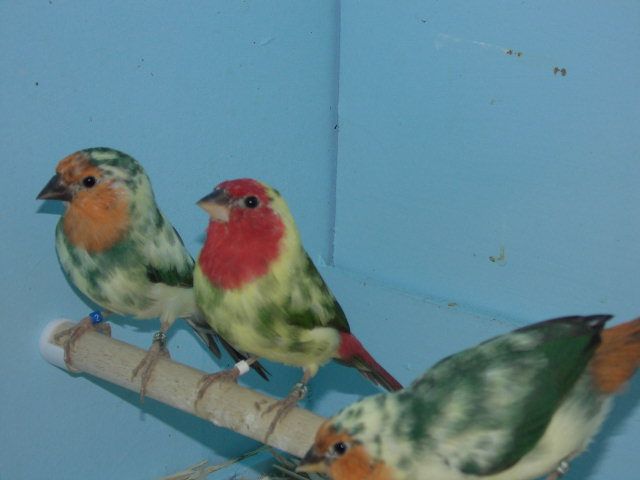
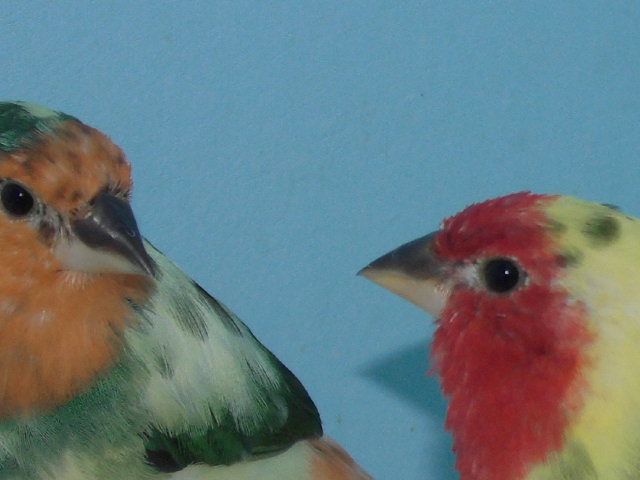
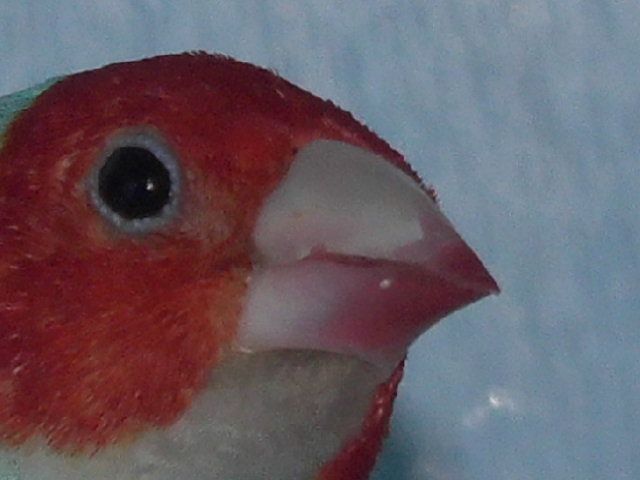
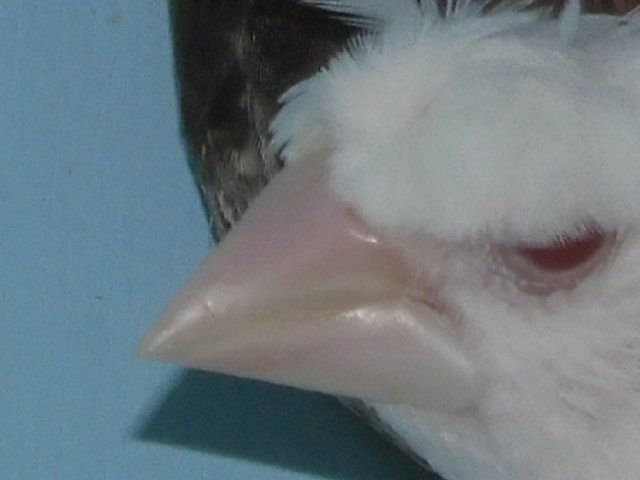

Juvenile parrot finches which went through a 2 week course of baytril finishing abou 3 weeks ago, build up is breaking down/clearing up on some of their beaks
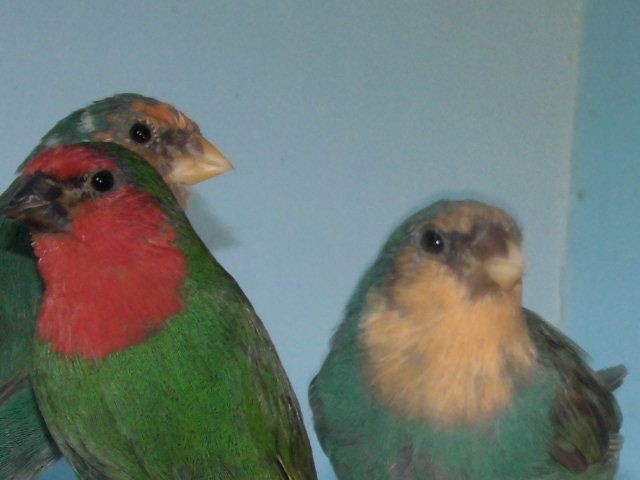
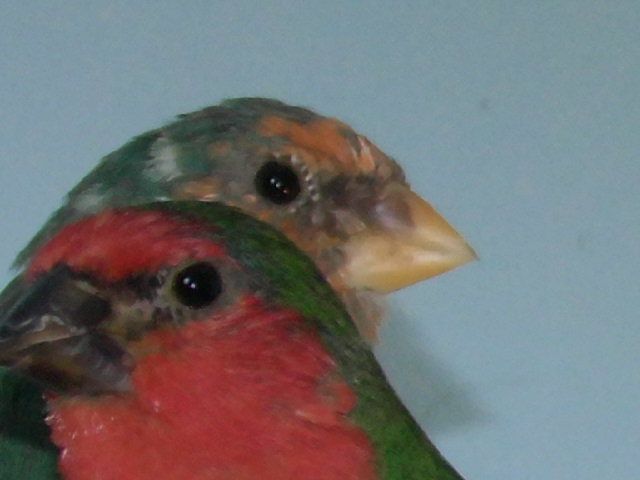





Juvenile parrot finches which went through a 2 week course of baytril finishing abou 3 weeks ago, build up is breaking down/clearing up on some of their beaks


Padraic

-
debbie276
- Bird Brain

- Posts: 14789
- Joined: Fri Aug 28, 2009 7:30 am
- Location: WV
Re: Build up on top of beak
Perfectly normal for beaks to flake now and then, I wouldn't worry that it was something to give meds over.
Debbie
long time breeder of lady gouldians:
Green
SF Pastel (SF Yellow)
Pastel (Yellow)
Blue
SF Pastel Blue (SF Yellow Blue)
Pastel Blue (Yellow Blue)
GREAT articles on avian lighting:
https://mickaboo.org/confluence/downloa ... ummary.pdf
http://www.naturallighting.com/cart/sto ... sc_page=56
long time breeder of lady gouldians:
Green
SF Pastel (SF Yellow)
Pastel (Yellow)
Blue
SF Pastel Blue (SF Yellow Blue)
Pastel Blue (Yellow Blue)
GREAT articles on avian lighting:
https://mickaboo.org/confluence/downloa ... ummary.pdf
http://www.naturallighting.com/cart/sto ... sc_page=56
- cindy
- Bird Brain

- Posts: 18754
- Joined: Wed Jul 22, 2009 8:33 pm
- Location: west central Florida
Re: Build up on top of beak
Personally, I see nothing abnormal... beaks do shed and flake off as Debbie mentioned.
Not sure I would have doses birds with the baytril unless showing signs of illness that required that particular antibiotic.
After using baytril it is recommended to use a probiotics for a few days.
Not sure I would have doses birds with the baytril unless showing signs of illness that required that particular antibiotic.
After using baytril it is recommended to use a probiotics for a few days.
Zebra, Gouldians, Java, CBM Shaft tail & Grasskeets
~ My Facebook groups ~
*Finchaholics ~ finches, hookbills, softbills & canaries are welcome here!
discussions regarding species, housing, breeding, preventatives, treatments
*Birdaholics ~ Avian Classified Ads Only
-
Smurf
- Sisal Slave

- Posts: 554
- Joined: Fri Jul 26, 2013 5:40 pm
- Location: Ireland
Re: Build up on top of beak
The Baytril was for another reason as 1 of the juveniles was fluffed up showing signs of going light so all juveniles in same flight were treated and are looking 100% healthy now. I was just surprised to see the dark build up on the beaks starting to clear up after the treatment as a side effect which has me thinking it shouldn't be normal.
Padraic

- MiaCarter
- Molting

- Posts: 3528
- Joined: Wed Apr 30, 2014 1:36 pm
- Location: SW Florida
Re: Build up on top of beak
I think they look great!
I see a little bit of flaking here and there, but that's totally normal. Beaks have a very similar structure to nails - layers - so it's normal to see the layers sometimes flake off here and there.
That is curious that it coincided with the Baytril. I can't think of how it would impact the beak in that way. The reason is because much of the beak is dead cells; the outer layers of the beak and the tip/edges of the beak are dead/dying cells - just like your nails. Much of the beak isn't served by a blood supply. So any systemic medication doesn't perfuse the beak cells (systemic treatments would only impact the inner core of the beak, the portion with a blood supply). That's why you need to apply beak mite medications topically - to get all those dead/dying cells that don't have a blood supply.
But -- but! -- antibiotics in the water could definitely impact the beak because the beak would be used to drink the medicated water.
So my best guess is that something in the Baytril weakened the bonds between the layers of the beak, causing the outer layer to flake off a bit. So I think that's my theory!
I also know that overly dry nails (e.g. from using lots of hot water and dish soap) are more apt to peel, and I've seen some evidence of this in larger hookbills during the cold, dry winter in our house that had forced hot air. So it's possible the Baytril caused some drying on the beaks, causing the flaking. That seems reasonable, I think.
As an aside, I've read that birds who drink highly mineralized water (hard water, I think?) can sometimes see white mineral traces on the beak and some flaking too. I've never seen it personally; only read about it. I don't think it's the case here, but just thought I'd mention it in case someone else happens to look up the thread in the future.
I see a little bit of flaking here and there, but that's totally normal. Beaks have a very similar structure to nails - layers - so it's normal to see the layers sometimes flake off here and there.
That is curious that it coincided with the Baytril. I can't think of how it would impact the beak in that way. The reason is because much of the beak is dead cells; the outer layers of the beak and the tip/edges of the beak are dead/dying cells - just like your nails. Much of the beak isn't served by a blood supply. So any systemic medication doesn't perfuse the beak cells (systemic treatments would only impact the inner core of the beak, the portion with a blood supply). That's why you need to apply beak mite medications topically - to get all those dead/dying cells that don't have a blood supply.
But -- but! -- antibiotics in the water could definitely impact the beak because the beak would be used to drink the medicated water.
So my best guess is that something in the Baytril weakened the bonds between the layers of the beak, causing the outer layer to flake off a bit. So I think that's my theory!
I also know that overly dry nails (e.g. from using lots of hot water and dish soap) are more apt to peel, and I've seen some evidence of this in larger hookbills during the cold, dry winter in our house that had forced hot air. So it's possible the Baytril caused some drying on the beaks, causing the flaking. That seems reasonable, I think.
As an aside, I've read that birds who drink highly mineralized water (hard water, I think?) can sometimes see white mineral traces on the beak and some flaking too. I've never seen it personally; only read about it. I don't think it's the case here, but just thought I'd mention it in case someone else happens to look up the thread in the future.
Humum to....
13 Zebra Finches....and 2 squeeps!
3 Society Finches
6 Gouldians
1 Weaver
1 Pintail Whydah
2 Cockatiels
2 Parakeets
....along with 1 MinPin, 1 Pug, 1 JRT, 1 Yorkie, 2 Chihuahuas and 15 cats.


www.PetFinchFacts.com
13 Zebra Finches....and 2 squeeps!
3 Society Finches
6 Gouldians
1 Weaver
1 Pintail Whydah
2 Cockatiels
2 Parakeets
....along with 1 MinPin, 1 Pug, 1 JRT, 1 Yorkie, 2 Chihuahuas and 15 cats.

www.PetFinchFacts.com
-
Smurf
- Sisal Slave

- Posts: 554
- Joined: Fri Jul 26, 2013 5:40 pm
- Location: Ireland
Re: Build up on top of beak
Does the beak grow from it's centre line out towards edges and tip ? as this would explain why the build up which normaly starts from nostrils is disappearing towards the side of upper beak on the juvenile in last photo.
I'm going to put flock through a test course of doxycycline plus to see if i notice any difference and whether droppings become less watery, i'll keep a very close eye on them and i have medistatin + probiotics at hand if required.
It will most likely take a good while for whatever deposit is to grow out of beak or break down and whether or not a visible result is noticed. As has been said it could be nothing with worst case scenario being that i'll be sure flock is clean.
I'm going to put flock through a test course of doxycycline plus to see if i notice any difference and whether droppings become less watery, i'll keep a very close eye on them and i have medistatin + probiotics at hand if required.
It will most likely take a good while for whatever deposit is to grow out of beak or break down and whether or not a visible result is noticed. As has been said it could be nothing with worst case scenario being that i'll be sure flock is clean.
Padraic

-
Smurf
- Sisal Slave

- Posts: 554
- Joined: Fri Jul 26, 2013 5:40 pm
- Location: Ireland
Re: Build up on top of beak
As an aside, I've read that birds who drink highly mineralized water (hard water, I think?) can sometimes see white mineral traces on the beak and some flaking too. I've never seen it personally; only read about it. I don't think it's the case here, but just thought I'd mention it in case someone else happens to look up the thread in the future.
This is another possibility which i hadn't considered as the water here is very hard.
Padraic

-
debbie276
- Bird Brain

- Posts: 14789
- Joined: Fri Aug 28, 2009 7:30 am
- Location: WV
Re: Build up on top of beak
If every bird is 100% healthy I don't understand why you are still treating with more medicine seeing how the beak condition is a normal thing and not an illness. 
Debbie
long time breeder of lady gouldians:
Green
SF Pastel (SF Yellow)
Pastel (Yellow)
Blue
SF Pastel Blue (SF Yellow Blue)
Pastel Blue (Yellow Blue)
GREAT articles on avian lighting:
https://mickaboo.org/confluence/downloa ... ummary.pdf
http://www.naturallighting.com/cart/sto ... sc_page=56
long time breeder of lady gouldians:
Green
SF Pastel (SF Yellow)
Pastel (Yellow)
Blue
SF Pastel Blue (SF Yellow Blue)
Pastel Blue (Yellow Blue)
GREAT articles on avian lighting:
https://mickaboo.org/confluence/downloa ... ummary.pdf
http://www.naturallighting.com/cart/sto ... sc_page=56
-
Smurf
- Sisal Slave

- Posts: 554
- Joined: Fri Jul 26, 2013 5:40 pm
- Location: Ireland
Re: Build up on top of beak
debbie276 wrote: If every bird is 100% healthy I don't understand why you are still treating with more medicine seeing how the beak condition is a normal thing and not an illness.
I'm also taking into consideration the number of clear clutches i've had both from the gouldians last winter and the parrot finches summer gone, none of the owls are showing same build up on beak and they bred very well with same water and diet.
The gouldians and parrot finches shared same sex flights autumn last year and have never shared same enclosure as any of the owls which are belgian birds.
Padraic

- cindy
- Bird Brain

- Posts: 18754
- Joined: Wed Jul 22, 2009 8:33 pm
- Location: west central Florida
Re: Build up on top of beak
I was reading a bit on beak "build up" on certain species... interesting they comment that hormones can also play a part in this. Wonder if this has anything to do with it. Just a thought.
Zebra, Gouldians, Java, CBM Shaft tail & Grasskeets
~ My Facebook groups ~
*Finchaholics ~ finches, hookbills, softbills & canaries are welcome here!
discussions regarding species, housing, breeding, preventatives, treatments
*Birdaholics ~ Avian Classified Ads Only
- MiaCarter
- Molting

- Posts: 3528
- Joined: Wed Apr 30, 2014 1:36 pm
- Location: SW Florida
Re: Build up on top of beak
Smurf - Yes, the beak grows from the base and center. It's a bit hard to explain in words - it would be easier to draw a picture - but it's similar to how a dog's nail grows, where you have a live core extending out a bit from the base.
So the newest growth would be at the base of the beak and near the center.
The oldest growth would be on the tip and the edges.
I've heard that about hormones having an impact on beak growth. There's a hormonal disorder that causes major beak issues though I don't recall what it is.
So the newest growth would be at the base of the beak and near the center.
The oldest growth would be on the tip and the edges.
I've heard that about hormones having an impact on beak growth. There's a hormonal disorder that causes major beak issues though I don't recall what it is.
Humum to....
13 Zebra Finches....and 2 squeeps!
3 Society Finches
6 Gouldians
1 Weaver
1 Pintail Whydah
2 Cockatiels
2 Parakeets
....along with 1 MinPin, 1 Pug, 1 JRT, 1 Yorkie, 2 Chihuahuas and 15 cats.


www.PetFinchFacts.com
13 Zebra Finches....and 2 squeeps!
3 Society Finches
6 Gouldians
1 Weaver
1 Pintail Whydah
2 Cockatiels
2 Parakeets
....along with 1 MinPin, 1 Pug, 1 JRT, 1 Yorkie, 2 Chihuahuas and 15 cats.

www.PetFinchFacts.com